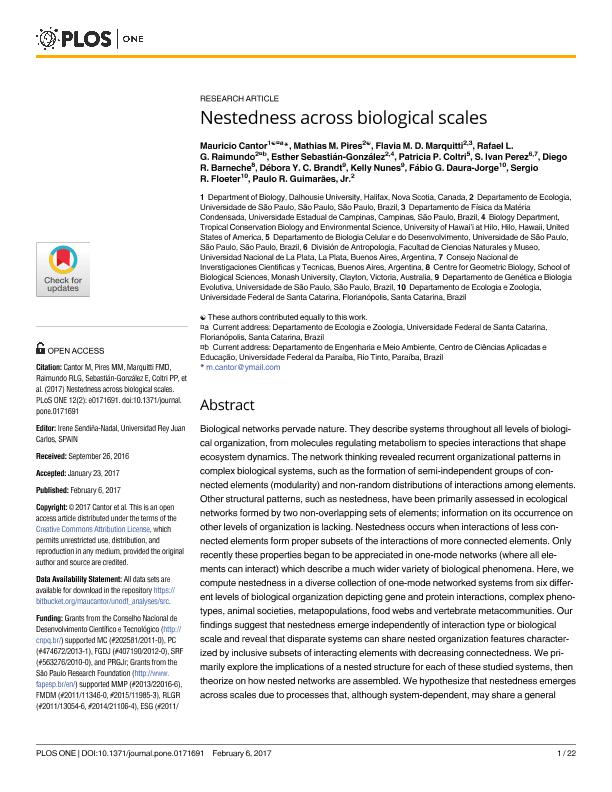Mostrar el registro sencillo del ítem
dc.contributor.author
Cantor, Mauricio
dc.contributor.author
Pires, Mathias M.
dc.contributor.author
Marquitti, Flavia M. D.
dc.contributor.author
Raimundo, Rafael L. G.
dc.contributor.author
Sebastián González, Esther
dc.contributor.author
Coltri, Patricia P.
dc.contributor.author
Perez, Sergio Ivan

dc.contributor.author
Barneche, Diego R.
dc.contributor.author
Brandt, Débora Y. C.
dc.contributor.author
Nunes, Kelly
dc.contributor.author
Daura-Jorge, Fábio G.
dc.contributor.author
Floeter, Sergio R.
dc.contributor.author
Guimaraes, Paulo Roberto

dc.date.available
2018-08-23T15:04:41Z
dc.date.issued
2017-02
dc.identifier.citation
Cantor, Mauricio; Pires, Mathias M.; Marquitti, Flavia M. D.; Raimundo, Rafael L. G.; Sebastián González, Esther; et al.; Nestedness across biological scales; Public Library of Science; Plos One; 12; 2; 2-2017; 1-22
dc.identifier.issn
1932-6203
dc.identifier.uri
http://hdl.handle.net/11336/56779
dc.description.abstract
Biological networks pervade nature. They describe systems throughout all levels of biological organization, from molecules regulating metabolism to species interactions that shape ecosystem dynamics. The network thinking revealed recurrent organizational patterns in complex biological systems, such as the formation of semi-independent groups of connected elements (modularity) and non-random distributions of interactions among elements. Other structural patterns, such as nestedness, have been primarily assessed in ecological networks formed by two non-overlapping sets of elements; information on its occurrence on other levels of organization is lacking. Nestedness occurs when interactions of less connected elements form proper subsets of the interactions of more connected elements. Only recently these properties began to be appreciated in one-mode networks (where all elements can interact) which describe a much wider variety of biological phenomena. Here, we compute nestedness in a diverse collection of one-mode networked systems from six different levels of biological organization depicting gene and protein interactions, complex phenotypes, animal societies, metapopulations, food webs and vertebrate metacommunities. Our findings suggest that nestedness emerge independently of interaction type or biological scale and reveal that disparate systems can share nested organization features characterized by inclusive subsets of interacting elements with decreasing connectedness. We primarily explore the implications of a nested structure for each of these studied systems, then theorize on how nested networks are assembled. We hypothesize that nestedness emerges across scales due to processes that, although system-dependent, may share a general.
dc.format
application/pdf
dc.language.iso
eng
dc.publisher
Public Library of Science

dc.rights
info:eu-repo/semantics/openAccess
dc.rights.uri
https://creativecommons.org/licenses/by-nc-sa/2.5/ar/
dc.subject
Biological Networks
dc.subject
Levels of Biological Organization
dc.subject
One-Mode Networks
dc.subject
Specificity
dc.subject
Affinity
dc.subject.classification
Otras Ciencias Biológicas

dc.subject.classification
Ciencias Biológicas

dc.subject.classification
CIENCIAS NATURALES Y EXACTAS

dc.title
Nestedness across biological scales
dc.type
info:eu-repo/semantics/article
dc.type
info:ar-repo/semantics/artículo
dc.type
info:eu-repo/semantics/publishedVersion
dc.date.updated
2018-08-21T18:35:55Z
dc.journal.volume
12
dc.journal.number
2
dc.journal.pagination
1-22
dc.journal.pais
Estados Unidos

dc.journal.ciudad
San Francisco
dc.description.fil
Fil: Cantor, Mauricio. Dalhousie University Halifax; Canadá
dc.description.fil
Fil: Pires, Mathias M.. Universidade de Sao Paulo; Brasil
dc.description.fil
Fil: Marquitti, Flavia M. D.. Universidade de Sao Paulo; Brasil. Universidade Estadual de Campinas; Brasil
dc.description.fil
Fil: Raimundo, Rafael L. G.. Universidade de Sao Paulo; Brasil
dc.description.fil
Fil: Sebastián González, Esther. Universidade de Sao Paulo; Brasil. University of Hawai’i at Hilo; Estados Unidos
dc.description.fil
Fil: Coltri, Patricia P.. Universidade de Sao Paulo; Brasil
dc.description.fil
Fil: Perez, Sergio Ivan. Consejo Nacional de Investigaciones Científicas y Técnicas; Argentina. Universidad Nacional de La Plata. Facultad de Ciencias Naturales y Museo. Departamento de Antropología; Argentina
dc.description.fil
Fil: Barneche, Diego R.. Monash University; Australia
dc.description.fil
Fil: Brandt, Débora Y. C.. Universidade de Sao Paulo; Brasil
dc.description.fil
Fil: Nunes, Kelly. Universidade de Sao Paulo; Brasil
dc.description.fil
Fil: Daura-Jorge, Fábio G.. Universidade Federal de Santa Catarina; Brasil
dc.description.fil
Fil: Floeter, Sergio R.. Universidade Federal de Santa Catarina; Brasil
dc.description.fil
Fil: Guimaraes, Paulo Roberto. Universidade de Sao Paulo; Brasil
dc.journal.title
Plos One

dc.relation.alternativeid
info:eu-repo/semantics/altIdentifier/doi/https://dx.doi.org/10.1371/journal.pone.0171691
dc.relation.alternativeid
info:eu-repo/semantics/altIdentifier/url/http://journals.plos.org/plosone/article?id=10.1371/journal.pone.0171691
Archivos asociados
